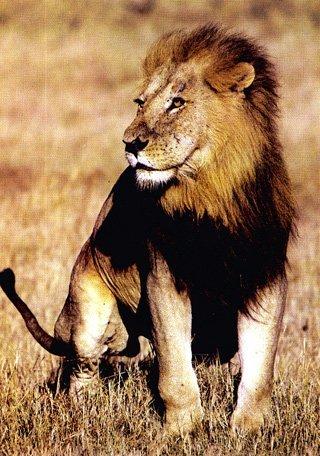
|
Home |
Day 5 - 8 | Day 9 - 12 | Day 13 - 17 | Day 18 - 21 | Trophy Room | Hunting Links | About Author |
Diary of an Africa Safari in Zambia, by Mr. Leslie E. Tassell

Panthera leo, the largest of the big cats, after the tiger. It is one of the "big five, roaring cats" and therefore is closely related to the tiger, leopard, Snow leopard and jaguar. The lion also has the distinction of being one of those species which originated in a climate considerably colder than the one in which it now lives. One does not have to go back very far in time to find traces of the lion in Europe.
Lions are solidly, somewhat stockily built, living on open plains they do not need the slender form adapted by others for gliding noiselessly through heavy cover. They stand about 36 in/9 m at the shoulder, having an overall length of between 9-10 ft/2.8 m at maturity and weighing up to 450 lb/204 kg. The female is smaller than the male, being some 6 in/15 cm shorter at the shoulder and weighing from 50 - 75 lb/22.7 - 34 kg less. The male bears a mane, which gives it the exaggerated impression of the size of the animal and has helped to foster the wrong idea that the lion, not the tiger is the larger.
The skeleton follows the general pattern of other cats, but the skull is more massive than in the tiger, for example. There are records of a skull measuring a much a 16 in/40 cm by 10 in/25 cm. The eyes are yellowish in color and have round pupils, whereas most cats have slits or at least oval pupils. The jaws are massive and powerful and the tongue has the usual papillae for grasping meat.
Although the lion is not as specialized a leaper as the tiger or lynx it can still perform some remarkable jumps. It is on record that lions have jumped as much as 12 ft/3.7 m vertically and 36 ft/10.8 m horizontally. Lions can and frequently the young do, climb trees, using the pulling power of the front legs to haul themselves up the trunk. A rough estimate of their power would be equal to the combined strength of ten men.
Lions live in groups called "prides" which can vary in size from 3 - 30. The pride is not strictly a family group, although the nucleus is typically formed of the leader, or king, several lionesses and their young. Average life span is less than 10 years in the wild, but lions have been known to live to 20+ years in captivity.
Lions are now a protected species only found in African veldts and scrub country and a few surviving Asiatic lions Panthera leo persica in the Gir Forest Reserve in Western, India. ------>